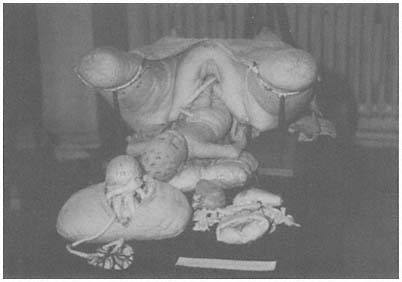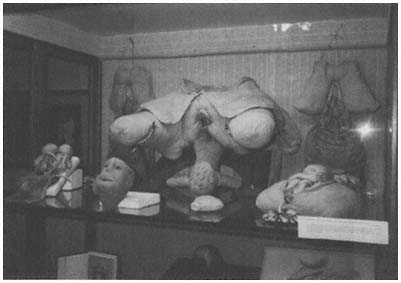10—
The "Machine":
Paris, 13 May 1756
After learning in the capital the art that I profess, and having practiced for sixteen years, destiny led me to the provinces. To earn the marks of esteem shown me by those who called me there, I announced that I would gladly give my advice to poor women who needed it. I cannot say the number who opened up to me about their sad situation, most of whom were afflicted with a loosening of the womb. I made them go into detail about their deliveries, and by the accounts they gave me I could not doubt that they attributed their infirmities to the ignorance of the women to whom they had recourse, or to that of some inexperienced village surgeons. My zeal therefore determined me to offer to give free lessons to these women. I made this proposition to the subdelegate, who, charmed to procure such a great benefit, accepted my offer. The only obstacle I found to my project was the difficulty of making myself understood by minds unaccustomed to grasping things except through the senses. I took the tack of making my lessons palpable by having them maneuver in front of me on a machine I constructed for this purpose, and which represented the pelvis of a woman, the womb, its opening, its ligaments, the conduit called the vagina, the bladder and rectum intestine . I added a model of a child of natural size, whose joints I made flexible enough to be able to put it in different positions; a placenta with its membranes and the demonstration of waters that they contain; the umbil-
ical cord composed of its two arteries and of the vein, leaving one half withered up, the other inflated, to imitate somewhat the cord of a dead child and that of a live child in which one feels the beating of the vessels that compose it.
I added the model of the head of a child separated from the trunk, in which the cranial bones are caved in on each other. I thought that with a demonstration this tangible, if I could not make these women very skilled, I would at least make them feel the necessity of asking for help soon enough to save the mother and child, help that cities do not lack, but that would be very necessary in the countryside, where the skill of a surgeon called too late is often useless, and he can only be the spectator of two expiring victims for whom his art and his zeal are by then fruitless. Thus my project was to have these women recognize the diverse dangers to which their incapacity exposes the mother and child.[1]
Large groups. Collective teaching. Students whose mental universe is quite distant. Here is the new challenge, very different from training a single apprentice whom you know well. So a palpable, concrete technique must be designed, one that features hands-on experience and practice, not theory and principles. Dealing with this new audience of rustics whose thoughts and worries are so alien, the midwife realizes that "it is to their eyes and their hands that [I] needed to speak."[2]
This, then, is the origin of the midwife's famous anatomical model, her upholstered "machine" with its womb and extractable baby doll (fig. 5). Upon this mannequin her students can practice, practice, and practice. The skin and soft organs are made of flesh-colored linen and pliant leather—some parts are redder and some paler—stuffed with padding, and the pelvic basin and various bones are at this point made of real skeletons, although later wood and wicker frames will be used. The different parts of the machine are numbered, and an accompanying table identifies all the anatomical names. Besides the main mannequin, as the midwife explains, there are many detached pieces, exhibits that allow a closer look at, for example, "the membranes showing the void filled with water in the middle of which the child swims."[3] The model is meant mostly for maneuvers that, as others confirm, allow her students to gain confidence, be "encouraged, and succeed perfectly."[4] Delivering babies from every conceivable position and presentation will prepare her students for all eventualities. But other auxiliary exhibits are meant also to warn and alarm, hence the flattened, shriveled umbilical


Figure 5.
The only known extant example of Mme du Coudray's obstetrical
"machine," made of wicker, fabric, leather, stuffing, and sponges. She
produced hundreds of these, but the others must have disintegrated with
use. This one is preserved in the Musée Flaubert, Rouen.
cord of a lifeless baby and the severed head with crushed cranium. This machine, as the midwife's followers will continue to testify, makes an "impression that can never be erased," "an advantage all the more essential because this class of surgeons and these women [of the countryside] do not have the resource of reading . . . [so] these daily continual maneuvers . . . [must be] vividly impressed on their senses."[5]
Today in Paris two distinguished surgeons, the midwife's old acquaintance Verdier and his colleague André Levret, "named by the Royal Academy of Surgery to examine a machine invented by la Dame du Coudray, Maîtresse Sage-Femme licensed in Paris, established in Clermont in Auvergne, to demonstrate the practice of delivery," approve it in a "very advantageous report."[6] She journeyed to the capital in April to show it to La Martinière, La Peyronie's successor as the king's first surgeon, whom she no doubt knows from her last years practicing in Paris, and he suggested she show it to the academy. It is an age when such innovations are recognized and prized; they sometimes even reap financial rewards in the form of royal pensions, and she has been led to believe she might be entitled to one of these. Officials in Auvergne tell Versailles about the good works she has done in their region which make her deserving of recompense, stressing especially her "spirit of charity that leads her to seek out the poor."[7]
But what is happening to this "spirit of charity"? The midwife has been motivated, she explains, to develop this device out of pitié .[8] This sentiment, however, is not simply sympathy or compassion. It is, as the books of the day and the Encyclopédie explain, a generous natural feeling brought out in the relatively prosperous by the sight of those who suffer or live in misery.[9] There is, in other words, a latent condescension embedded in the concept. Somehow, the midwife's genuine calling to help these country women has reinforced her sense of superiority. The city-trained, modernizing midwife responds to the flocks of women who divulge to her their secret distress, and she gains their trust. But she then imposes on them a sophisticated diagnosis. As she sees it, ignorance is the culprit, and she with her mechanistic explanations of anatomy will serve as a vector of science, of progress. She seems increasingly shaped by the spirit if not the letter of the Encyclopédie , five volumes of which have now appeared. This influential work, so scathingly critical of midwifery as "superstitiously" practiced, may be inspiring her to create
a very new and different image of her trade, one that is not folkloric but simple and free of danger, not secretive but transparent, not haphazard but professional. To promote her craft and win over its critics, she is reframing it using their conventions and language. She is always evolving new strategies.
That she refers to her obstetrical mannequin as a "machine" is telling. This is not an idiom that would naturally occur to her students, "mes femmes," as she calls them. They do not have, until they work with her, a mechanical view of birthing. The midwife is speaking here the language of enlightenment and reform, one well understood by the men she seeks to impress, but altogether foreign to her female pupils. Although she is grateful to the women for opening her eyes to a problem, for giving her a raison d'être, her own motives and agenda are shifting. Requesting unabashedly the reward she believes is her due for this invention, voyaging to Paris to defend her interests and make known her own new technology, the midwife puts a new spin on things. Her original altruistic devotion and a newer entrepreneurial zeal are conflating now. Thus far in her career her allegiance has been to the women, the mothers who seek her help and expertise, share confidences, bond with her. That was true in Paris, and has continued in her Clermont practice so far.
But with the introduction of the machine, by which she hopes to profit, some separating has necessarily begun. She is working on a different plane here, generalizing about bodies in the most impersonal terms. Since Descartes, writers in France have assumed that lack of freedom is inherent in all mechanical devices. He equated the animal body with an automaton, but to explain human free will he depended on his theory of the soul.[10] Where, then, is the soul in the midwife's mechanical teaching? What kind of message is communicated by the objectified pelvis she now deploys on such a grand scale? The animate individual, the person in the patient, the organic whole could start to fade from view if she is not careful. Does she realize any of this as, armed with the male establishment's official approval of her machine, she heads back to Auvergne?